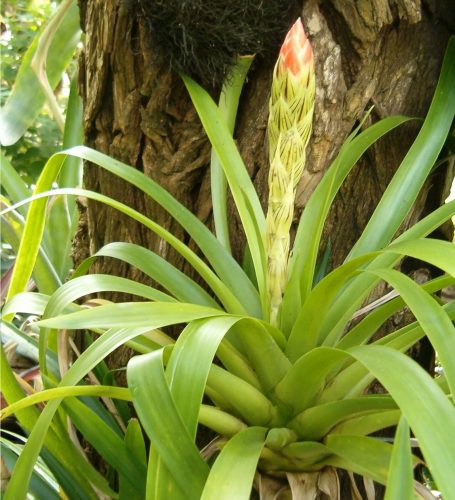Genetic Diversity and Spatial Genetic Structure of Guzmania monostachia (Bromeliaceae) in Florida
 Bromeliaceae are a neotropical plant family consisting of around 3140 species in eight traditional subfamilies. The subject of this research is the genus Guzmania Ruiz & Pav., specifically the Florida native species Guzmania monostachia(L.) Rusby ex Mez. In 1989, an invasive bromeliad-eating weevil, Metamasius callizona Chevrolat (Coleoptera: Curculionidae), was introduced into Florida from Mexico, endangering most of Florida’s native bromeliads, including G. monostachia. Our goals are to: 1) to reconstruct the evolutionary history of Tillandsioideae using phylogenomic approaches with an emphasis on understanding the origin of Guzmania and G. monostachia lineages; 2) assemble a reference genome for G. monostachia; and 3) use population genomic approaches to quantify the genetic diversity and spatial genetic structure of Florida populations of G. monostachia. This research is desperately needed to assess the full impact of M. callizona on G. monostachia populations in Florida, as well as to identify sources of population-level diversity that may be important for future pest-mitigation and targeted conservation efforts. Conservation of bromeliads is critical because the water collected in their leaf bases, known as a “phytotelmata”, sustains life for a variety of unique aquatic organisms, and also serves as an important source of hydration for animals during the dry winter season.
Bromeliaceae are a neotropical plant family consisting of around 3140 species in eight traditional subfamilies. The subject of this research is the genus Guzmania Ruiz & Pav., specifically the Florida native species Guzmania monostachia(L.) Rusby ex Mez. In 1989, an invasive bromeliad-eating weevil, Metamasius callizona Chevrolat (Coleoptera: Curculionidae), was introduced into Florida from Mexico, endangering most of Florida’s native bromeliads, including G. monostachia. Our goals are to: 1) to reconstruct the evolutionary history of Tillandsioideae using phylogenomic approaches with an emphasis on understanding the origin of Guzmania and G. monostachia lineages; 2) assemble a reference genome for G. monostachia; and 3) use population genomic approaches to quantify the genetic diversity and spatial genetic structure of Florida populations of G. monostachia. This research is desperately needed to assess the full impact of M. callizona on G. monostachia populations in Florida, as well as to identify sources of population-level diversity that may be important for future pest-mitigation and targeted conservation efforts. Conservation of bromeliads is critical because the water collected in their leaf bases, known as a “phytotelmata”, sustains life for a variety of unique aquatic organisms, and also serves as an important source of hydration for animals during the dry winter season.
Krupar, S., Naranjo, A.A., Godden, G., Cellinese, N. 2023. The fate of Guzmania monostachia in Florida rests with humans. Diversity 15(4): 525. https://doi.org/10.3390/d15040525